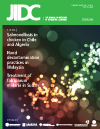Can treatment delay be utilized as a key variable for monitoring the pool of infectious tuberculosis in a population?
DOI:
https://doi.org/10.3855/jidc.211Keywords:
Tuberculosis, Diagnostic Delay, Treatment Delay, Community Health Services, Health SurveysAbstract
Background: A major goal of tuberculosis control programs is to stop community transmission of Mycobacterium tuberculosis. However, this can not be rapidly accomplished because, in endemic areas, most of the population is already infected, serving as a reservoir that continuously contributes to the pool of infectious cases. Tuberculin surveys are the main tools used to monitor the infectious pool, but there are serious methodological constraints, and they require resources and expertise that are often unavailable. There is an urgent need for alternative means to monitor the epidemic at the local level.
Methodology: We investigated whether a systematic registration of treatment delay in the tuberculosis program records of the Amhara Region of Ethiopia could be utilized to estimate the infectious pool of tuberculosis.
Results: The study showed that the total number of infectious days and hence an estimate of the infectious pool could be calculated by recording the treatment delay for new TB cases, retreatment cases and failures, and by estimating the number of undiagnosed cases . Of these categories, treatment delay among new smear-positive tuberculosis cases contributes the greatest number of infectious days.
Conclusions: A local tuberculosis program can use a systematic recording of treatment delay as a quantifiable variable to monitor the infectious pool, and can also serve as a key indicator of program performance.
Downloads
Published
How to Cite
Issue
Section
License
Authors who publish with this journal agree to the following terms:
- Authors retain copyright and grant the journal right of first publication with the work simultaneously licensed under a Creative Commons Attribution License that allows others to share the work with an acknowledgement of the work's authorship and initial publication in this journal.
- Authors are able to enter into separate, additional contractual arrangements for the non-exclusive distribution of the journal's published version of the work (e.g., post it to an institutional repository or publish it in a book), with an acknowledgement of its initial publication in this journal.
- Authors are permitted and encouraged to post their work online (e.g., in institutional repositories or on their website) prior to and during the submission process, as it can lead to productive exchanges, as well as earlier and greater citation of published work (See The Effect of Open Access).








